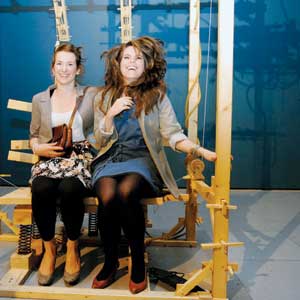Silicon Valley made a name for itself by piecing together small parts in a big way, so it’s fitting that Bernie Lubell’s tech-inspired exhibit should also find a home here at the San Jose Institute of Contemporary Art. Constructed as four interrelated mechanical units and a series of two-dimensional designs, Lubell’s “Conservation of Intimacy” is a testament to both the beauty and anxiety that technology brings us as well as an exploration of the tensions that such a paradox implies.
Lubell’s mechanical installation is large and complex, with primitive wooden pulleys, cogs, wheels and latex hoses creating a surreal, medieval-workshop-like setting. Lubell, who hails from San Francisco, draws his inspiration from his engineering and psychology background, as well as from early scientific inventions, particularly those of 19th-century French physiologist Étienne-Jules Marey, whose polygraph experiments are reflected in Lubell’s work.
In one piece, Lubell uses a pneumatic tubing system to control a pen that then transcribes the pulsing movement of two people rocking on a wooden bench. Meanwhile, a third person pedals a stationary bicycle, turning a cog and enabling the pen to continue up the roll of paper. Though the movement is exterior, Lubell’s machines measure more than physics; they record what transpires when three people fall in sync.
That’s one of the main ideas of the exhibit—the necessity of human relationships in order to fully appreciate the machinery’s capabilities. Just as each unit depends on another, so do visitors to the exhibit. Because the machines require at least two people to operate them, a visit to the gallery without a companion would be, for the most part, unsuccessful; restoring intimacy to the visitor’s experience is the only solution.
And the “intimacy” element is decidedly sexual: touching is not only encouraged, but required. Lubell’s piece titled Making a Point of Inflection encourages one person to press against another but separates them with a thin latex wall, reminiscent of skin or contraceptives, a symbol of the detachments we willingly or unwillingly maintain. Seemingly crude and counterintuitive, “Conservation of Intimacy” is not what we’ve been taught to expect when we consider technology, but that’s part of what makes it so provocative and so challenging. Immersing ourselves in Lubell’s exhibit forces us to question our own assumptions about what technology should do for us and instead realize what we can do for each other.

 Bill Maher at Montalvo
Bill Maher at Montalvo  Cabrillo Fest: Week Two
Cabrillo Fest: Week Two 

